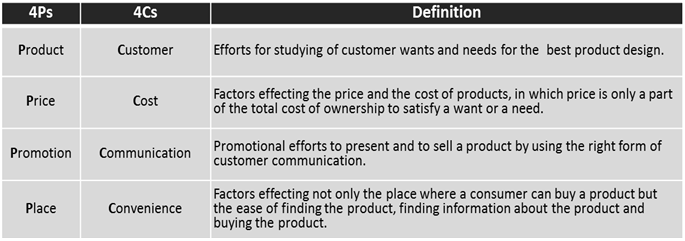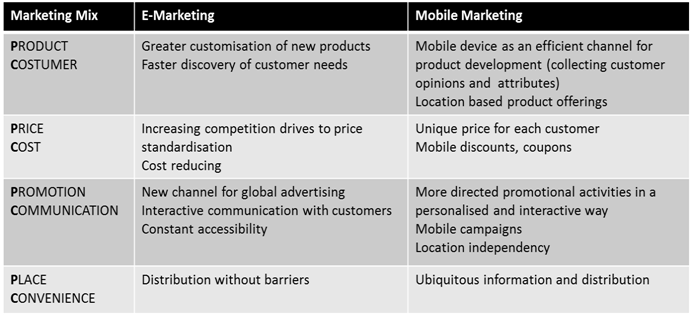-
Paper Information
- Next Paper
- Previous Paper
- Paper Submission
-
Journal Information
- About This Journal
- Editorial Board
- Current Issue
- Archive
- Author Guidelines
- Contact Us
Management
p-ISSN: 2162-9374 e-ISSN: 2162-8416
2014; 4(3A): 1-11
doi:10.5923/s.mm.201401.01
Contribution of QR-Codes to the Marketing Mix − A Case Study
Müge Klein
Department for Business Administration, Turkish-German University, Istanbul, 34820, Turkey
Correspondence to: Müge Klein, Department for Business Administration, Turkish-German University, Istanbul, 34820, Turkey.
| Email: |  |
Copyright © 2014 Scientific & Academic Publishing. All Rights Reserved.
The mobilisation of IT-applications over the past few years has opened up new opportunities for business companies to develop mobile marketing strategies. QR-Codes, as the most popular way of mobile tagging, enable a pull mobile marketing strategy, wherein customers can request information about products or services that interest them by scanning a code with their mobile devices. This study provides an assessment of the potential contribution of QR-Codes to marketing mix elements, using the familiar framework of the four Ps (product, price, promotion, place) and the four Cs (costumer, cost, communication, convenience). In order to investigate the influences of QR-Codes in the context of marketing mix elements, a case study about QR-Code based mobile marketing activities of B/S/H/ Turkey (one of the leading electronic home appliances companies in Turkey) is presented.
Keywords: QR-Codes, Marketing Mix, Mobile Tagging, Mobile Marketing
Cite this paper: Müge Klein, Contribution of QR-Codes to the Marketing Mix − A Case Study, Management, Vol. 4 No. 3A, 2014, pp. 1-11. doi: 10.5923/s.mm.201401.01.
Article Outline
1. Introduction
- The fast development of networking technologies and mobile devices gives rise to mobilisation of business processes and as a matter of course, influences companies’ marketing strategies. Marketing strategy is defined as the marketing logic by that the company decides which customers to be targeted and how to serve and satisfy them [1]. Mobile marketing is based on a marketing strategy that helps companies to promote their products and services through interaction with customers via their mobile devices [2]. Mobile tagging is one of the many possibilities to provide mobile marketing that enables customers requesting information about products or services by scanning a bar-code with their mobile devices [3]. QR-Codes are a popular way of mobile tagging because of their ease of use and production [4]. Smart phones with a camera and an appropriate reader application can be used to scan a QR-Code. By developing its overall marketing strategy, the company designs the details of the marketing mix that is made up of factor groups such as product, price, promotion and place [1]. Even though mobile marketing is a part of direct marketing which is one of the possibilities of the promotion mix such as advertising, personal selling, etc. [1], it also affects other marketing mix elements [5]. One important factor for the success of mobile marketing is its ability to adapt to every marketing mix element [6]. Therefore by developing a QR-Code based marketing strategy, it has to be examined how QR-Codes can affect the marketing mix elements. Earlier studies about QR-Codes are either technical, explaining how QR-Codes function [7, 8, 9, 10, 11], or present various forms of QR-Code usage scenarios for different business purposes [11, 12, 13, 14] or exploratory and present results of case studies and surveys about QR-Codes [15, 16, 17, 18, 19, 20]. On the other hand, the studies about mobile marketing have a more state-of-the-art review character, and they are more about the general definition [21, 22, 23, 24, 25], classification [26, 27] and success factors of mobile marketing [28] and less about the combination of mobile marketing and marketing mix. Smutkupt et al. studied the effects of mobile marketing on marketing mix elements in their work and state that mobile marketing has a tremendous impact across all marketing mix elements [5]. This study aims to provide an assessment of the potential contribution of QR-Codes to marketing mix using the familiar framework of the four Ps (product, price, promotion, place) and the four Cs (consumer, cost, communication, convenience). The four Ps framework is a product-oriented approach of marketing mix and the four Cs is a customer-oriented one. The reason for taking both frameworks into consideration is that they regard identical topics from different perspectives which can be relevant for determining QR-Code effects on marketing mix. The research about QR-Codes indicates that mobile marketing through QR-Codes contributes more or less to all marketing mix elements (4Ps and 4Cs), particularly to the element promotion because of the informative character of QR-Codes. In order to investigate the contributions of QR-Codes to the elements of marketing mix in practice, a case study will be examined. The case study is about B/S/H/ (Bosch Siemens Hausgeräte) Turkey, which is one of the leading electronic home appliances companies in Turkey, represented by four different brands in the market. This work is structured as follows: First, basic information about QR-Codes and mobile marketing is presented, followed by a short summary of marketing mix and the impacts of QR-Codes on its elements. Then the case study about B/S/H Turkey’s QR-Code based marketing activities and its results are presented. The article ends with concluding remarks and suggestions for future work.
2. QR-Codes in the Context of Mobile Marketing
- For years, barcodes are being used to identify products especially in logistics. A two-dimensional code called “Quick Response Code (QR-Code)” is one of the most commonly applied codes in many areas due to its large data capacity. It is also used in mobile marketing applications [11]. In this section, the application of the QR-Code technology for mobile marketing is examined. In this regard, at first, QR-Code technology is introduced, subsequently, the definitions of mobile marketing and various possible QR-Code supported mobile marketing strategies are specified.
2.1. QR-Code Technology
- The QR-Code, represented in Figure 1, is a sort of barcode developed in 1994 by the Japanese company Denso Wave, which is active in the vehicle production sector [4, 11, 14]. QR-Codes are open codes, which are easier to produce than other two dimensional codes such as DataMatrix, mCode, Aztecc, etc., which have more data capacity and can be scanned faster and easier [11, 17]. While the classical barcode contains data in just one direction, the QR-Code technology contains horizontal and vertical data such that it can encode the same amount of data on a smaller space [11]. The production as well as the reading of QR-Codes is easy for the user, and both activities are supported by appropriate software [11]. Software used in the synthesis of QR-Code can be applied without special programming skills and hence QR-Codes can be produced fast and easily. The decoding of QR-Codes is performed with a freeware on a mobile phone with a camera that is used to read the code from a certain distance. The mobile phone is held before the code and the scanned code activates the appropriate software to decode it. As seen in Figure 1, the user gains access to any form of information (text, URL, image, audio, video, etc.) after the code is decoded by the application [29].
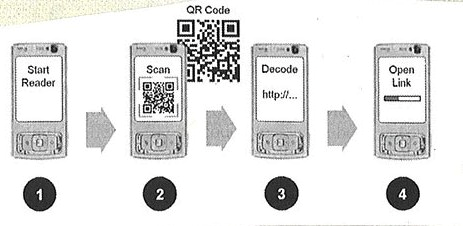 | Figure 1. QR-Code Scanning [29] |
2.2. Mobile Marketing
- According to the standard definition of Mobile Marketing Association [30], mobile marketing is the set of practices that enables organisations to communicate and engage with their audience in an interactive and relevant manner through any mobile device or network. Shortly defined, mobile marketing is marketing of products and services via mobile devices of customers [2]. The goals of mobile marketing are the same as traditional marketing, such as increasing customer retention and satisfaction, customer acquisition, branding and market research, which can be achieved by different ways enabled by mobile technologies. Mobile marketing offers new opportunities in customer communication and in time- and location-sensitive product offerings [5, 31, 32]. Based on these definitions for mobile marketing, its unique characteristics can be summarised as follows [5, 31]:§ Ubiquity/Portability: Mobile marketing activities are ubiquitous. The users are able to receive information and to perform tasks wherever they are and whenever they want with their portable and small devices.§ Two-way-communication/Interactivity: Easy connec- tivity with mobile devices used in mobile marketing activities enables more frequent interactions between the marketer and the customer in either direction. § Personalisation/Customer Adaptation: Promotional information or services can be personalised for each user. The information content can be adapted according to user’s attributes, for example special advertising content for disabled people. § Localisation: The possibility of identifying the user’s geographical position through various location-based technologies provides marketers the opportunity to target location sensitive promotional offers to mobile device users.There are many possible technologies and tools enabling mobile marketing such as short messaging and multimedia messaging services, mobile online sites, interactive voice response (IVR), ringback tone (RBT), location based services, mobile games, mobile payments, mobile TV, mobile social networking and mobile tagging [1, 25].
2.3. QR-Codes and Mobile Marketing
- There are two main types of mobile marketing depending on which domain (the marketer or the customer) the initiator of the marketing activity is [32]. There are push-based and pull-based mobile marketing. In push-based mobile marketing, the marketing content is sent to the customer, just like sending an SMS to the customers’ mobile devices. Pull-based mobile marketing, also known as reverse mobile marketing or on demand mobile marketing [27, 33], requires consumers to initiate the process of seeking product information (e.g. over the Web) and communicate with marketers with their mobile devices. Pull-based mobile marketing is possible with technologies like mobile intern, e-mails or SMS, wherein the customer sends an e-mail or an SMS to the marketer and expects an appropriate response or wherein the customer performs a web-based search for product information via his/her mobile phone. But these technologies can be also used by the marketer to initiate the marketing activity in the context of push-based mobile marketing strategies. When compared to the technologies discussed earlier, QR-Codes constitute an exclusively pull-based mobile marketing technology.Customers scan a QR-Code only when they wish to get more information about a product or a service or to participate in a marketing campaign. Therefore, QR-Code based marketing activities are classified under pull-based mobile marketing. Among other technologies enabling pull-based mobile marketing strategies (such as searching for special product/service information on the Web or sending messages for participating in marketing campaigns), QR-Codes are more effective, because they can pack various forms of information which can be reached easily by the user and they can be created and modified easily by the marketer [34]. QR-Code usage in mobile marketing can be classified into two different types based on the following: The placement of the code and the information it contains [14, 35]: a. Possible (but not limited) places, where QR-Codes can be placed, are: § Billboards§ Posters§ Product brochures§ Brand catalogues§ On the product or its package§ Newspapers and magazines§ Websites§ Social media channelsb. Possible (but not limited) information that can be contained in QR-Codes are:§ Advertising slogans§ Product information§ Product picture/audio/video§ Price information§ Instruction manuals§ Telephone number§ URL of a Web site§ Product comments§ Campaign information§ Discount coupons§ Tickets§ Games§ Ring tonesThe places and the information can be combined in all possible ways which results in different applications and different marketing strategies. For example, a product video can be accessed by scanning a QR-Code on a billboard or a discount coupon retrieved by scanning a QR-Code on a newspaper advertisement or the price information of a product can be accessed by scanning a QR-Code on a product brochure.
3. Impacts of QR-Codes on Marketing Mix
- The marketing mix is at the core of marketing and is useful in helping marketers to structure their marketing activities [36]. Novel technologies, such as QR-Codes, influence the elements of marketing mix. In this chapter, after introducing the elements of the marketing mix, the impacts of QR-Codes on marketing mix are analysed.
3.1. Marketing Mix
- The so-called ‘marketing mix’ is a conceptual framework that is particularly useful in structuring a marketing strategy [36]. The four basic elements of marketing mix, first proposed by McCarthy, are the 4Ps– Product, Price, Promotion and Place (or Distribution) [37]. 4Ps marketing mix elements are generated from the product’s point of view [38, 39] and do not recognise customer needs directly. Later, in 1990, Lauterborn proposed a 4Cs classification-Customer, Cost, Communication and Convenience which is a more consumer-oriented version of the 4Ps [40]. Table 1 shows the correspondence among 4P and 4C marketing mix elements and their common definitions [1, 5, 36, 41].
|
3.2. QR-Codes and Marketing Mix
- In order to analyse the effects of QR-Codes on marketing mix elements, it is advantageous to examine first the influences of electronic marketing, especially of mobile marketing on the elements of marketing mix because QR-Codes is an enabling technology of mobile marketing, and mobile marketing is a subset of e-marketing.E-marketing developed in the era of e-business can be simply expressed as the usage of electronic communication technology to achieve goals of marketing [36]. As marketing on the Internet is an entirely different process from traditional marketing, it required changes in marketing mix elements [42]. Mobile marketing as a part of mobile commerce is based on the novelties stemming from e-marketing and has also led to some improvements in the marketing mix. Table 2 summarises the impacts of e-marketing and mobile marketing on the marketing mix elements – 4Ps and 4Cs.
|
|
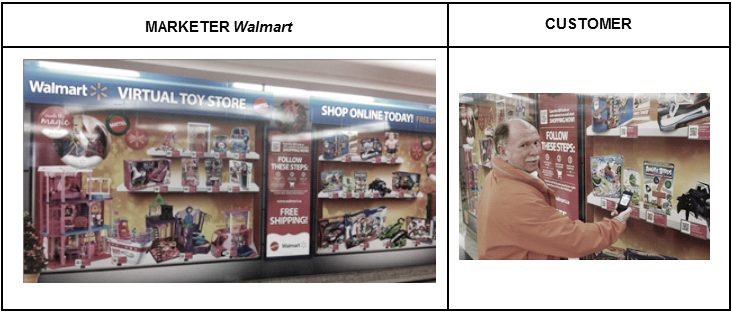 | Figure 2. Walmart’s Virtual Toy Store [46] |
4. Case Study: B/S/H/ Turkey
- In order to investigate the effects of QR-Codes on marketing mix elements in real life, a business case is examined. The study is exploratory and based on a single case [47, 48]. The unit of analysis is B/S/H/ Turkey’s marketing portfolio and the method used for data collection of the qualitative research is in-depth interview. Information was provided by the managers of B/S/H/ on how QR-Codes are used in the company. The research question of the study is:§ How do QR-Codes influence the elements of marketing mix?
4.1. B/S/H/ Turkey
- B/S/H/ − Bosch und Siemens Hausgeräte GmbH is the largest manufacturer of electronic home appliances in Europe and one of the leading companies in this sector, worldwide. The group was founded in 1967 as a joint venture between Robert Bosch GmbH (Stuttgart) and Siemens AG (Munich). Today, B/S/H/ operates 40 factories in 13 countries in Europe, the US, Latin America and Asia with a total workforce of about 50.000 personnel. B/S/H/ Turkey operate 6 factories, one call centre and several technical after sales service centres in Turkey. The main brands of B/S/H/ Turkey are Bosch and Siemens; with its special brand ‘Gaggenau’, B/S/H/ Turkey caters to the individual wishes of consumers and the regional brand ‘Profilo’ ensures a broad presence in their respective home market. B/S/H/ Turkey offers consultancy, montage, maintenance and repair services, pre- and after sales. Besides traditional marketing channels, B/S/H Turkey makes use of mobile marketing channels, such as advertisements on company’s webpage, social media channels, such as Facebook, Twitter, etc., blogs and online news sites.
4.2. B/S/H/ Turkey’s QR-Code Marketing Activities
- B/S/H/ Turkey has been using QR-Codes in different areas for different purposes since two years. The use of QR-Code can be considered to be in its trial period; since QR-Codes are not very popular known in Turkey, hence the company does not want to invest too much in this yet. While planning QR-Codes for various marketing activities, B/S/H/ Turkey also examined how its core competitors use QR-Codes and discovered that the usage of QR-Codes is primarily limited to product brochures, leading to product information or product videos. Since B/S/H/ Turkey discovered less QR-Code oriented applications by its competitors, it sees itself ahead of their market competitors in using QR-Code technology for marketing purposes. Four different in practice realised and five different planned QR-Code usage scenarios in B/S/H/ Turkey can be detailed. The QR Code applications that are already in practice include the following:1. QR-Codes on product-price brochures/catalogues leading to product informationProduct-price brochures of all the brands are sent to dealers monthly and product catalogues are sent yearly. The brochures and catalogues are supplied in limited numbers. This problem is dealt with QR-Code support: When customers scan the QR-Code on a product brochure or catalogue, they get the same information provided in the brochures and the catalogues online in HTML format. In the example in Figure 3, the QR-Code is placed on the lower left corner of the product brochure on Bosch white home appliances. Scanning the code will lead the customer to information of all products represented in that brochure.
 | Figure 3. A sample product brochure |
 | Figure 4. A sample product catalogue |
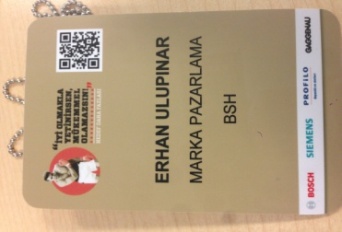 | Figure 5. QR-Code on ID badge |
 | Figure 6. QR-Code on exhibition stands |
4.3. Findings
- The findings of this study indicate that QR-Code technology is used for all the brands of B/S/H/ Turkey in different marketing activities, such as in campaign brochures, in stores, on products themselves, etc. The major contribution of QR-Codes is on the marketing mix element, promotion/communication. QR-Code scanning leads mostly to extra product or service information. The influences of QR-Codes on other marketing mix elements are not observed in this case study. Two planned usage scenarios alone concern not only the promotional activities but also the marketing mix element, place/convenience since it should make it possible to purchase products after scanning the code (see Table 4).
|
5. Conclusions
- The results of this study offer key insights to theory and practice both. Theoretically, this work investigates the effects of mobile marketing and especially, the effects of QR-Codes on marketing mix elements of the 4Ps and the 4Cs. On the practical side, the findings of the theoretical work are investigated within a case study. In practice, the outcomes of these effects and their advantages are realised gradually. The major influence of QR-Codes is on the communication/ promotion element of marketing mix since QR-Codes give customers the possibility of easy access to various forms of information and they constitute a customer initiated pull-based mobile marketing strategy. Even when QR-Codes have been used just for the promotion/communication mix in the case under study, there is a positive tendency towards a wider use of QR-Codes in all remaining marketing mix elements assuming that QR-Code based marketing strategies are accepted by customers, and success is promising. In this regard, further studies can be focused on the analysis of QR-Code usage of customers with respect to its quantitative effects on marketing activities.
ACKNOWLEDGEMENTS
- The author wishes to thank Mrs. Burçin Uzunhasan Girit and Mrs. Damla Gürkan as representatives of B/SH/ Turkey for their efforts in the development of the presented case study research.
References
| [1] | P. Kotler and G. Armstrong , Principles of Marketing, Global Edition, England, Pearson, 2014. |
| [2] | A. Gao and J. Küpper, “Emerging technologies for Mobile Commerce,” Journal of Theoretical and Applied Electronic Commerce Research, 1 (2), Editorial, i-v, 2006. |
| [3] | E. S. B. Meydanoğlu and M. Klein, “Commercial Utilization of Mobile RFID,” in M. B. I. Reaz (Ed.) Radio Frequency Identification from System to Applications, InTech, Croatia, 245-265, 2013. |
| [4] | N. Stadler, Mobile Tagging im Marketing, ein Überblickswerk mit Schwerpunkten Near Field Communication (NFC) und QR Code, AVM Verlag, München, 2010. |
| [5] | P. Smutkupt, D. Krairit, and V. Esichaikul, “Mobile Marketing: Implications for Marketing Strategies,” IJMM Winter, 5 (2), 126-139, 2010. |
| [6] | B. W. Wirtz and S. Ulrich, “Mobile Marketing im Multi-Channel-Marketing,“ in Erfolgsfaktoren des Mobile Marketing, H. Bauer et. al. (Ed.), Springer Verlag, 165-181, 2008. |
| [7] | J. Rouillard, “Contextual QR Codes,” Proceedings of the Third International Multi-Conference on Computing in the Global Information Technology, ICCGI 2008, Athens, Greece, 2008. |
| [8] | K. Sorensen and N.R. Glassman, “Point and Shoot: Extending Your Reach with QR Codes,” Journal of Electronic Resources in Medical Libraries, 8(3), 286-293, 2011. |
| [9] | F. O'Hara, “QR Codes What You Absolutely Must Know About Them,” Home Business', November/December, 30-33, 2012. |
| [10] | A. Probst, “The Expectations of Quick Response (QR) Codes in Print Media: An Empirical Data Research Anthology,” UW-L Journal of Undergraduate Research XV, 1-13, 2012. |
| [11] | I. Uitz and M. Harnisch, “Der QR-Code – aktuelle Entwicklungen und Anwendungsbereiche,“ Informatik Spektrum, 35-5, 339-347, 2012. |
| [12] | X. Dou and H. Li, “Creative use of QR Codes in consumer communication,” International Journal of Mobile Marketing, 3(2), 61-67, 2008. |
| [13] | T. Shiang-Yeng, L. Y. Foo, and R. Idrus, “Application of Quick Response (QR) Codes in Mobile Tagging System for Retrieving Information about Genetically Modified Food,” in Advances in Data Networks, Communications, Computers , 9th WSEAS International Conference DNCOCO, Portugal, 114-118, 2010. |
| [14] | M. Arslan, “Kare Kodlar ile Hayatımız Değişecek,” Bilim ve Teknik, Haziran, 78-79, 2011. |
| [15] | S. Narang, V. Jain, and S. Roy, “Effect of QR Codes on consumer attitudes,” IJMM Summer, 7 (2), 52-64, 2012. |
| [16] | J. H. Jung, R. Somerstein, and E. S. Kwon, “Should I scan or should I go? Young consumers’ motivations for scanning QR Code advertising,” International Journal of Marketing Management, IJMM, 7(3), 25-36, 2012. |
| [17] | S. Okazaki, H. Li, and M. Hirose, "Benchmarking the Use of QR Code in Mobile Promotion", Journal of Advertising Research 52(1), 102-117, March 2012. |
| [18] | J. S. Ryu, “Mobile Marketing Communications in the retail environment: a comparison of QR code users and non-users,” IJMM, 8 (2), 19-29, Winter 2013. |
| [19] | B. Sago, “The Usage Level and Effectiveness of Quick Response (QR) Codes for Integrated Marketing Communication Purposes among College Students,” International Journal of Integrated Marketing Communications, 7-17, Fall 2011. |
| [20] | S. Böhm and S. J. Niklas, “Mobile Tagging in the german market: A comparative study on user and non-user characteristics,” International Journal of Business and Management Studies, 4 (2), 161-170, 2012. |
| [21] | Ş. Karaca and M. Gülmez, “Mobil pazarlama: Kavramsal bir değerlendirme,” Akademik Yaklaşımlar Dergisi, 1 (1), 2010. |
| [22] | H. H. Bauer, T. Dirks, and M. D. Bryant, “Die Zukunft des Mobile Marketing: Ein Leitfaden für eine erfolgreiche Umsetzung,” in H. Bauer, M.D. Bryant, and T. Dirks (Eds.) Erfolgsfaktoren des Mobile Marketing, 3-15, Springer Berlin Heidelberg, 2009. |
| [23] | J. Schäfer and D. Toma, “Trends und Strategien im Mobile Marketing,” in H. Bauer, M.D. Bryant, and T. Dirks (Eds.) Erfolgsfaktoren des Mobile Marketing, 17-31, Springer Berlin Heidelberg , 2009. |
| [24] | S. Barutçu, “Mobil Viral Pazarlama,” IUYD 2(1), 6-14, 2011. |
| [25] | K. Varnalı, A. Toker, and C. Yılmaz, Mobile Marketing Fundamentals and Strategy, McGrawHill, 2011. |
| [26] | S. Balasubramanian, R. A. Peterson, and S. L. Jarvenpaa, “Exploring the Implications of M-Commerce for Markets and Marketing,” Journal of the Academy of Marketing Science, 30, 348-361, 2002. |
| [27] | G. Ye, “Mobile Marketing Systems: Framework and technology enabler,” International Journal of Mobile Marketing, IJMM, 2 (1), 43-49, 2007. |
| [28] | A. Scharl, A. Dickinger, and J. Murphy, “Diffusion and Success Factors of Mobile Marketing,” Electronic Commerce Research and Applications, 4 (2), 159-173, 2005. |
| [29] | S. J. Niklas and S. Böhm, “Increasing Using Intention of Mobile Information Services via Mobile Tagging,” UBICOMM 2011: The Fifth International Conference on Mobile Ubiquitous Computing, Systems, Services and Technologies, Lisbon, Portugal, 98-104, 20-25 November 2011. |
| [30] | MMA (Mobile Marketing Association) 2008,http://mmaglobal.com/wiki/mobile-marketing, accessed: 21 March 2014. |
| [31] | V. Shankar and S. Balasubramanian, “Mobile Marketing: A Synthesis and Prognosis,” Journal of Interactive Marketing, 23, 118-129, 2009. |
| [32] | P. Pousttchi and D. G. Wiedemann, “A Contribution to Theory Building for Mobile Marketing: Categorizing Mobile Marketing Campaigns through Case Study Research,” MPRA Paper No. 2925, University of Augsburg, April 2007. |
| [33] | A. Sharmaa and J. N. Sheth, “Web-based marketing The coming revolution in marketing thought and strategy,” Journal of Business Research 57, 696 – 702, 2004. |
| [34] | W. Zhu, D. Wang, and H. Sheng, “Mobile RFID Technology for Improving M-Commerce” http://wns.ice.cycu.edu.tw/wireless/Mobile, accessed 21 July 2012. |
| [35] | M. Hegen, “Mobile Tagging: Potenziale von QR-Codes im Mobile Business,” Hamburg, Diplomica Verlag GmbH, 2010. |
| [36] | M. J. Baker and S. Hart, The Marketing Book, Elsevier, USA, 2008. |
| [37] | E. J. McCarthy, Basic Marketing: A Managerial Approach, 6th edition, Homewood, Ill., Irwin, 1978. |
| [38] | N. Öndoğan, “Restoran pazarlamasında kullanılan temel pazarlama karma elemanları,” Ege Stratejik Araştırmalar Dergisi, 1 (1), 45-67, 2010. |
| [39] | M.Özmen, C. Uzkurt, Ş. Özdemir, R. Altunışık, and Ö. Torlak, “Pazarlama İlkeleri,” T.C. Anadolu Üniversitesi Yayını No: 3012, Eskişehir, 2013. |
| [40] | R. Lauterborn, “New Marketing Litany: Four Ps Passe; C-words take over,” Advertising Age, 61 (41), 26, 1999. |
| [41] | C.C. Krueger, N. Lu, and P. M. C. Swatman, “Success factors for online music marketing – eTransformation: From the four P’s to the four C’s,” in Proceedings of CollECTeR Latin America, Santiago, Chile, 2003. |
| [42] | R. Eid, and M. Trueman, “The Internet: new international marketing issues,” Management Research News, 25 (12), 54-67, 2002. |
| [43] | E. Constantinides, “The marketing mix revisited: Towards the 21st century marketing,” Journal of Marketing Management, 22, 407-438, 2006. |
| [44] | G. Dominici, “From marketing mix to e-marketing mix: a literature overview and classification,” International Journal of Business and Management, 4 (9), 17-24, 2009. |
| [45] | E. Constantinides, “The 4S web-marketing mix model,” Electronic Research and Applications 1, 57-76, 2002. |
| [46] | Walmart Case Example, Awesome Examples of QR Codes in Marketinghttp://www.creativeguerrillamarketing.com/mobile-marketing-2/awesome-examples-of-qr-codes-in-marketing/, accessed: 24.01.2014. |
| [47] | R. K. Yin, Case study research: Design and methods (2nd ed.). Thousand Oaks, Beverly Hills, London, Sage Publishing, 1994. |
| [48] | J. Rowley, “Using Case Studies in Research,” Management Research News, 25 (1), 16-27, 2002. |
 Abstract
Abstract Reference
Reference Full-Text PDF
Full-Text PDF Full-text HTML
Full-text HTML